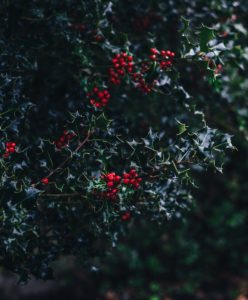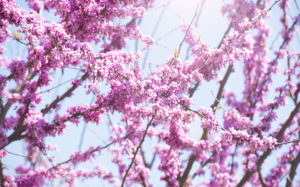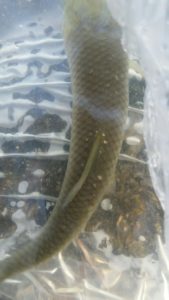October 4, 2021
A Guide to Buckhorn Inn’s Nature Trail (Part 1)
As many guests know, the Buckhorn Inn Nature Trail is about a mile long and takes about an hour. It is important to wear appropriate shoes as some sections are moderately steep. A complete map of the route and a printed guide is available in our office. To whet your appetite, here are some highlights!
Beginning the Trail
The Nature Trail begins with this historic 1938 Inn itself. Before the Inn was built, a mountain cabin with rough hewn timbers, shake roof, and stone fireplace occupied the site. Douglas Bebb purchased the property from Lying Bill Price—a mountaineer who was well-known for his tall tales.
Inside the Inn’s front door is the dining room and veranda. This spot offers a beautiful view of Mt. LeConte, the third highest mountain in the Great Smoky Mountains National Park. This is a popular spot for dinner guests to enjoy a glass of wine before their meal.
Back outside the front door and to the left you will see a sloping path through the woods. To your right you will see Rosebay rhododendrons which usually reach
the peak of their white blooms in June. As you continue down the trail you will see American holly on both sides.
To your left you will see the John and Nettie Hill Garden which features native plants.http://www.tnps.org
Near trail marker number 5 you will see the Callaway Garden, which was established in 2001. This garden features both sun and shade plants, including many native flowers and shrubs.
You will than go to the right to pick up the trail down to the Buckhorn Pond. On your way you will see the Umbrella magnolia at marker number 6. If you examine the trunks carefully, you will see neat rows of holes made by sapsuckers eating the sap and the insects trapped in it.
Approaching the Pond
Near marker number 7 you will see redbud and white-flowered dogwood trees that make a beautiful spring combination. There also is an American chestnut tree in this area. We are thankful it escaped the blight.
One of the most abundant trees in the area is the tulip tree. A member of the magnolia family, the tree was called the Apollo of the Woods by poet Walt Whitman because it grows tall and straight.
You will now find yourself near the spring fed Buckhorn Pond. It is home to two mute swans, Bubble and Squeak. Bass, carp, koi and perch all call the pond home. You also may see frogs or the occasional turtle. Birds attracted to the pond include wood ducks, spotted sandpipers, and herons.
Please visit our blog next week for the next segment of our Trail Guide!
January 29, 2018
Nature Trail Trees Provide Year-Round Beauty
Have you stopped to notice the many different trees on the Buckhorn Inn Nature Trail? If you are here in the spring, you will be sure to notice our redbud trees with their striking magenta flowers. They contrast beautifully with the white-flowered dogwoods.
You also will find several specimens of American hornbeam, also know as ironwood or blue beech. It is called “ironwood because of the strong appearance of the bark. The saw-toothed leaves are very distinctive and turn orange to red in the fall.
Our trail features a southern red oak–an important contributor to our fall parade of colors. Nearby you will find an eastern hemlock. It has long horizontal branches, very small cones, and graceful foliage that nearly touches the ground. Hemlock was once extensively logged, and the bark was used to make tannic acid for tanning animal hides. We treat our hemlocks to prevent the wooly adelgid. This pest has decimated hemlocks in many other areas.
Perhaps no other tree is a s beautiful as the red maple. In the fall ours turns brilliant shades of red, yellow and orange–spectacular against the blue sky!
We have only one native pine on our property. It is an eastern white pine with five needles to a bundle.
While you are walking the trail, do not miss our two fragrant cloud dogwoods. Douglas Bebb discovered these trees on the Buckhorn property and patented them. You can see documents relating to this on display in our library. This rare mutation produces scented blossoms. Like the many types of dogwood found in the Smokies, the fragrant cloud is noted for its showy blossoms and scarlet berries. In the fall, these berries become an important source of food for wildlife. Native Americans used the rough bark to obtain red dye.
Trees are not the only highlight of the trail
If you have never walked our nature trail, we highly recommend you do so. The walk takes about an hour and covers about a mile. If you decide to only walk part of the trail, there are several points which make for an easy return. Be sure to wear proper footwear and to watch your step. Please stop by the Buckhorn Inn office to pick up a map that shows the route and the locations of numbered informational stakes.
October 2, 2017
Carp-e Diem! New Denizens of Buckhorn Pond
Have you visited Buckhorn Pond? The spring-fed pond was created after Douglas Bebb built a dam there in the early 1950’s. The pond was designed with an ingenious overflow to protect the dam during heavy rains. Bass, carp and perch make their home here, as well as frogs, turtles and a few snakes. The brilliantly-colored wood duck, spotted sandpiper, heron, and other water fowl are attracted here.
We are responsible caretakers of our property, and invited a representative from the Tennessee Department of Natural Resources to review Buckhorn Pond and provide advice. He told us that our water and surrounding area is in excellent shape! His only recommendation was that a species of carp, the grass carp, could help us more easily maintain optimum levels of water plants.
Grass Carp Released in Pond
Our research revealed that the local farmers’ co-op is visited about once a month by a truck selling live fish. We went there on “fish truck day” and purchased six 12″-long triploid grass carp. The size was important as the naturalist told us if they were too small they could be eaten by the bass, and if they were done growing, they would not eat many water plants.
Innkeeper John and daughter-in-law Sharon took the large plastic bags filled with water and carp down to the pier. They “tempered” the fish by adding water from the pond to the bags until the temperatures equaled. Then they lowered the bags into the water and let the fish swim out. They report the fish looked happy in their new home!
The grass carp is a large, herbivorous, fresh-water fish. It is used as a food fish in China, but in the United States and Europe used mainly for controlling aquatic weeds. The use of these fishy friends lessens use of herbicides. The fish live up to 11 years and eat three times their weight in vegetation daily. They grow rapidly, as much as 10 inches in a summer. The average length of a fully-grown grass carp is around 30″. The grass carp are sterile and will not produce young in our pond.
For more information on stocking ponds, visit http://tn.gov/twra/article/fish-for-stocking.








Gatlinburg Weather
Click for weather forecast